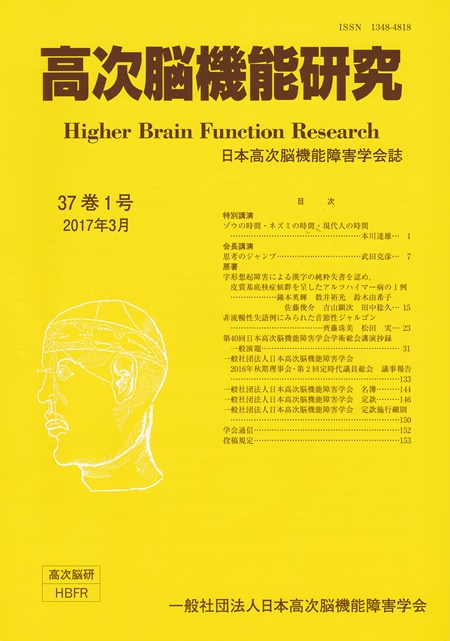Volume 37, Issue 1
Displaying 1-46 of 46 articles from this issue
- |<
- <
- 1
- >
- >|
Special lecture
-
2017 Volume 37 Issue 1 Pages 1-6
Published: March 31, 2017
Released on J-STAGE: April 01, 2018
Download PDF (352K)
President‘s lecture
-
2017 Volume 37 Issue 1 Pages 7-14
Published: March 31, 2017
Released on J-STAGE: April 01, 2018
Download PDF (555K)
Original article
-
2017 Volume 37 Issue 1 Pages 15-22
Published: March 31, 2017
Released on J-STAGE: April 01, 2018
Download PDF (710K) -
2017 Volume 37 Issue 1 Pages 23-30
Published: March 31, 2017
Released on J-STAGE: April 01, 2018
Download PDF (585K)
-
2017 Volume 37 Issue 1 Pages 31-33
Published: 2017
Released on J-STAGE: April 01, 2018
Download PDF (1103K) -
2017 Volume 37 Issue 1 Pages 33-35
Published: 2017
Released on J-STAGE: April 01, 2018
Download PDF (1104K) -
2017 Volume 37 Issue 1 Pages 36-38
Published: 2017
Released on J-STAGE: April 01, 2018
Download PDF (1104K) -
2017 Volume 37 Issue 1 Pages 38-40
Published: 2017
Released on J-STAGE: April 01, 2018
Download PDF (1105K) -
2017 Volume 37 Issue 1 Pages 40-43
Published: 2017
Released on J-STAGE: April 01, 2018
Download PDF (1111K) -
2017 Volume 37 Issue 1 Pages 43-45
Published: 2017
Released on J-STAGE: April 01, 2018
Download PDF (1104K) -
2017 Volume 37 Issue 1 Pages 45-48
Published: 2017
Released on J-STAGE: April 01, 2018
Download PDF (1112K) -
2017 Volume 37 Issue 1 Pages 48-50
Published: 2017
Released on J-STAGE: April 01, 2018
Download PDF (1103K) -
2017 Volume 37 Issue 1 Pages 50-52
Published: 2017
Released on J-STAGE: April 01, 2018
Download PDF (1103K) -
2017 Volume 37 Issue 1 Pages 53-54
Published: 2017
Released on J-STAGE: April 01, 2018
Download PDF (1098K) -
2017 Volume 37 Issue 1 Pages 54-56
Published: 2017
Released on J-STAGE: April 01, 2018
Download PDF (1105K) -
2017 Volume 37 Issue 1 Pages 57-59
Published: 2017
Released on J-STAGE: April 01, 2018
Download PDF (1105K) -
2017 Volume 37 Issue 1 Pages 59-61
Published: 2017
Released on J-STAGE: April 01, 2018
Download PDF (1103K) -
2017 Volume 37 Issue 1 Pages 61-64
Published: 2017
Released on J-STAGE: April 01, 2018
Download PDF (1111K) -
2017 Volume 37 Issue 1 Pages 64-67
Published: 2017
Released on J-STAGE: April 01, 2018
Download PDF (1112K) -
2017 Volume 37 Issue 1 Pages 67-69
Published: 2017
Released on J-STAGE: April 01, 2018
Download PDF (1104K) -
2017 Volume 37 Issue 1 Pages 69-71
Published: 2017
Released on J-STAGE: April 01, 2018
Download PDF (1103K) -
2017 Volume 37 Issue 1 Pages 71-74
Published: 2017
Released on J-STAGE: April 01, 2018
Download PDF (1110K) -
2017 Volume 37 Issue 1 Pages 74-76
Published: 2017
Released on J-STAGE: April 01, 2018
Download PDF (1104K) -
2017 Volume 37 Issue 1 Pages 76-79
Published: 2017
Released on J-STAGE: April 01, 2018
Download PDF (1111K) -
2017 Volume 37 Issue 1 Pages 79-81
Published: 2017
Released on J-STAGE: April 01, 2018
Download PDF (1104K) -
2017 Volume 37 Issue 1 Pages 81-84
Published: 2017
Released on J-STAGE: April 01, 2018
Download PDF (1113K) -
2017 Volume 37 Issue 1 Pages 84-86
Published: 2017
Released on J-STAGE: April 01, 2018
Download PDF (1106K) -
2017 Volume 37 Issue 1 Pages 86-88
Published: 2017
Released on J-STAGE: April 01, 2018
Download PDF (1104K) -
2017 Volume 37 Issue 1 Pages 88-91
Published: 2017
Released on J-STAGE: April 01, 2018
Download PDF (1111K) -
2017 Volume 37 Issue 1 Pages 91-93
Published: 2017
Released on J-STAGE: April 01, 2018
Download PDF (1105K) -
2017 Volume 37 Issue 1 Pages 93-95
Published: 2017
Released on J-STAGE: April 01, 2018
Download PDF (1106K) -
2017 Volume 37 Issue 1 Pages 95-98
Published: 2017
Released on J-STAGE: April 01, 2018
Download PDF (1112K) -
2017 Volume 37 Issue 1 Pages 98-100
Published: 2017
Released on J-STAGE: April 01, 2018
Download PDF (1104K) -
2017 Volume 37 Issue 1 Pages 100-103
Published: 2017
Released on J-STAGE: April 01, 2018
Download PDF (1112K) -
2017 Volume 37 Issue 1 Pages 103-105
Published: 2017
Released on J-STAGE: April 01, 2018
Download PDF (1106K) -
2017 Volume 37 Issue 1 Pages 105-107
Published: 2017
Released on J-STAGE: April 01, 2018
Download PDF (1106K) -
2017 Volume 37 Issue 1 Pages 107-109
Published: 2017
Released on J-STAGE: April 01, 2018
Download PDF (1108K) -
2017 Volume 37 Issue 1 Pages 109-112
Published: 2017
Released on J-STAGE: April 01, 2018
Download PDF (1113K) -
2017 Volume 37 Issue 1 Pages 112-114
Published: 2017
Released on J-STAGE: April 01, 2018
Download PDF (1105K) -
2017 Volume 37 Issue 1 Pages 114-117
Published: 2017
Released on J-STAGE: April 01, 2018
Download PDF (1112K) -
2017 Volume 37 Issue 1 Pages 117-119
Published: 2017
Released on J-STAGE: April 01, 2018
Download PDF (1104K) -
2017 Volume 37 Issue 1 Pages 119-122
Published: 2017
Released on J-STAGE: April 01, 2018
Download PDF (1110K) -
2017 Volume 37 Issue 1 Pages 122-124
Published: 2017
Released on J-STAGE: April 01, 2018
Download PDF (1104K) -
2017 Volume 37 Issue 1 Pages 124-127
Published: 2017
Released on J-STAGE: April 01, 2018
Download PDF (1109K) -
2017 Volume 37 Issue 1 Pages 127-130
Published: 2017
Released on J-STAGE: April 01, 2018
Download PDF (1109K) -
2017 Volume 37 Issue 1 Pages 130-132
Published: 2017
Released on J-STAGE: April 01, 2018
Download PDF (1104K)
- |<
- <
- 1
- >
- >|
